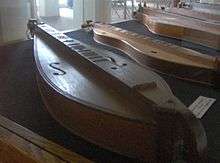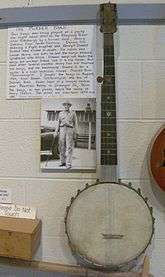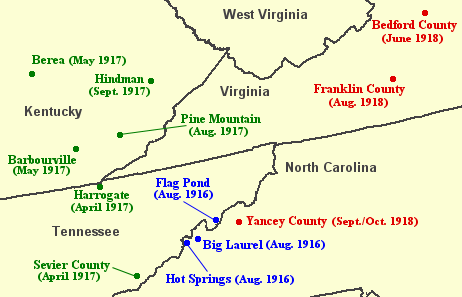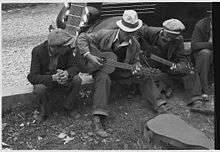Appalachian music
Appalachian music is the music of the region of Appalachia in the Eastern United States. It is derived from various European and African influences, including English ballads, Irish and Scottish traditional music (especially fiddle music), hymns, and African-American blues. First recorded in the 1920s, Appalachian musicians were a key influence on the early development of Old-time music, country music, and bluegrass, and were an important part of the American folk music revival of the 1960s. Instruments typically used to perform Appalachian music include the banjo, American fiddle, fretted dulcimer, and guitar.[3][4][5][6][7][8]
| Appalachian music | |
|---|---|
| Stylistic origins | |
| Cultural origins | 18th century, Appalachia, United States |
| Typical instruments | |
| Derivative forms | Country music |

Early recorded Appalachian musicians include Fiddlin' John Carson, G. B. Grayson & Henry Whitter, Bascom Lamar Lunsford, the Carter Family, Clarence Ashley, and Dock Boggs, all of whom were initially recorded in the 1920s and 1930s. Several Appalachian musicians obtained renown during the folk revival of the 1950s and 1960s, including Jean Ritchie, Roscoe Holcomb, Ola Belle Reed, Lily May Ledford, Hedy West and Doc Watson. Country and bluegrass artists such as Loretta Lynn, Roy Acuff, Dolly Parton, Earl Scruggs, Chet Atkins, The Stanley Brothers and Don Reno were heavily influenced by traditional Appalachian music.[3]
History

Immigrants from England, the Scottish lowlands, and Ulster arrived in Appalachia in the 17th and 18th centuries, and brought with them the musical traditions of these regions, consisting primarily of English and Scottish ballads— which were essentially unaccompanied narratives— and dance music, such as reels, which were accompanied by a fiddle.[3]
Many Appalachian ballads, such as "Pretty Saro", "The Cuckoo", "Pretty Polly", and "Matty Groves", descend from the English ballad tradition and have known antecedents there. Other songs popular in Appalachia, such as "Young Hunting," "Lord Randal," and "Barbara Allen", have lowland Scottish roots.[9] The dance tune "Cumberland Gap" may be derived from the tune that accompanies the Scottish ballad "Bonnie George Campbell".[10]
Several fiddle tunes popular in Appalachia have origins in Gaelic-speaking regions such as western Ireland and the Scottish Highlands--for example "Leather Britches," based on "Lord MacDonald's Reel."[11] Printed versions of these were very popular and common throughout the British Empire in the eighteenth century, including North America, and would likely have spread into Appalachia as a result. This explains the presence of these tunes in a region which had relatively little Gaelic-speaking settlement.
The early immigrants also brought a form of church singing called lining out, in which one person sings a line of a psalm or hymn and the rest of the congregation responds. This type of congregational singing, once very common all over colonial America, is now largely restricted to Old Regular Baptist churches in the hills of southwest Virginia and eastern Kentucky. These congregations usually sing American or English hymns.
The British music changed gradually after generations of American settlement. Songs were transformed lyrically as the descendants of the settlers forgot the people and events that originally inspired them, though some maintained references to British place names. Additionally, influences from the music of other settlers, including Germans, Dutch, French Huguenots, and in particular African Americans would have ensured that the new music developed a sound all its own.

The "New World" ballad tradition, consisting of ballads written in North America, was as influential as the Old World tradition to the development of Appalachian music. New World ballads were typically written to reflect news events of the day, and were often published as broadsides.[3] New World ballads popular among Appalachian musicians included "Omie Wise", "Wreck of the Old 97", "Man of Constant Sorrow," and "John Hardy". Later, coal mining and its associated labor issues led to the development of protest songs, such as "Which Side Are You On?" and "Coal Creek March".[12]
One of the most iconic symbols of Appalachian culture— the banjo— was brought to the region by African-American slaves in the 18th century. Black banjo players were performing in Appalachia as early as 1798, when their presence was documented in Knoxville, Tennessee.[13] African-American blues, which spread through the region in the early 20th century, brought harmonic (such as the third and seventh blue notes, and sliding tones) and verbal dexterity to Appalachian music, and many early Appalachian musicians, such as Dock Boggs and Hobart Smith, recalled being greatly influenced by watching black musicians perform.[14][15]
Other instruments such as the guitar, mandolin, and autoharp became popular in Appalachia in the late 19th century as a result of mail order catalogs. These instruments were added to the banjo-and-fiddle outfits to form early string bands.[3] The fretted dulcimer— often called the "Appalachian" or "mountain" dulcimer due to its popularity in the region— emerged in Southwest Pennsylvania and Northwest Virginia in the 19th century. It is thought to have been a modification of a German instrument. Unrelated to the hammered dulcimer, the fretted dulcimer is essentially a modified zither. In the early 20th century, settlement schools in Kentucky taught the fretted dulcimer to students, helping spread its popularity in the region. Singer Jean Ritchie was largely responsible for popularizing the instrument among folk music enthusiasts in the 1950s.[16]
Collecting and recording
Fieldwork
Around the turn of the 20th century, a broad movement developed to record the rich musical heritage, particularly of folksong, that had been preserved and developed by the people of the Appalachians. This music was unwritten; songs were handed down, often within families, from generation to generation by oral transmission. Fieldwork to record Appalachian music (first in musical notation, later on with recording equipment) was undertaken by a variety of scholars.[17]
One of the earliest collectors of Appalachian ballads was Kentucky native John Jacob Niles (1892–1980), who began noting ballads as early as 1907 as he learned them in the course of family, social life, and work. Due to fears of plagiarism and imitation of other collectors active in the region at the time, Niles waited until 1960 to publish his first 110 in The Ballad Book of John Jacob Niles. The area covered by Niles in his collecting days, according to the map in the Ballad Book, was bounded roughly by Tazewell, Virginia; south to Boone and Saluda, North Carolina and Greenville, South Carolina; west to Chickamauga, Georgia; north through Chattanooga and Dayton, Tennessee to Somerset, Kentucky; northwest to Bardstown, Frankfort, and Lexington, Kentucky; east to the West Virginia border, and back down to Tazewell, thus covering areas of the Smokies, the Cumberland Plateau, Upper Tennessee Valley, and the Lookout Mountain region.[18]
In May 1916, the soprano Loraine Wyman and her pianist colleague Howard Brockway visited the Appalachians in eastern Kentucky, in a 300-mile walking trek to gather folk songs. They took their harvest back to New York, where they continued, with great success, their ongoing efforts in performing traditional folk songs to urban audiences.[19]

Starting only about a month after Wyman and Brockway, the British folklorists Cecil Sharp and Maud Karpeles toured the Southern Appalachian region, visiting places like Hot Springs in North Carolina, Flag Pond in Tennessee, Harlan in Kentucky, and Greenbrier County in West Virginia, as well as schools such as Berea College and the Hindman Settlement School in Kentucky and the Pi Beta Phi settlement school in Gatlinburg, Tennessee. They persisted for three summers in all (1916-1918), collecting over 200 "Old World" ballads in the region, many of which had varied only slightly from their British Isles counterparts. After their first study in Appalachia, Sharp and Karpeles published English Folk Songs from the Southern Appalachians.[20]
Among the ballads Sharp and Karpeles found in Appalachia were medieval-themed songs such as "The Elfin Knight" and "Lord Thomas and Fair Ellinor", and seafaring and adventure songs such as "In Seaport Town" and "Young Beichan". They transcribed 16 versions of "Barbara Allen" and 22 versions of "The Daemon Lover" (often called "House Carpenter" in Appalachia).[21] The work of Sharp and Karpeles confirmed what many folklorists had suspected— the remote valleys and hollows of the Appalachian Mountains were a vast repository of older forms of music.[22]
Commercial recordings
Only a few years after folk music fieldwork had begun to flourish, the commercial recording industry had developed to the point that recording Appalachian music for popular consumption had become a viable enterprise.[23]
In 1923, OKeh Records talent scout Ralph Peer held the first recording sessions for Appalachian regional musicians in Atlanta, Georgia. Musicians recorded at these sessions included Fiddlin' John Carson, a champion fiddle player from North Georgia.[23] The commercial success of the Atlanta sessions prompted OKeh to seek out other musicians from the region, including Henry Whitter, who was recorded in New York City in 1924. The following year, Peer recorded a North Carolina string band fronted by Al Hopkins that called themselves "a bunch of hillbillies." Peer applied the name to the band, and the success of the band's recordings led to the term "Hillbilly music" being applied to Appalachian string band music.[22]
In 1927, Peer, then working for the Victor Talking Machine Company, held a series of recording sessions at Bristol, Tennessee that to many music historians mark the beginning of commercial country music.[22] Musicians recorded at Bristol included the Carter Family and Jimmie Rodgers. Other record companies, such as Columbia Records and ARC, followed Peer's lead and held similar recording sessions. Many early Appalachian musicians, including Clarence Ashley and Dock Boggs, experienced a moderate level of success. The onset of the Great Depression in the early 1930s, however, reduced demand for recorded music, and most of these musicians fell back into obscurity.[14]
Folk revival
In the 1930s, radio programs such as the Grand Ole Opry kept interest in Appalachian music alive, and collectors such as musicologist Alan Lomax continued to make field recordings in the region throughout the 1940s. In 1952, Folkways Records released the landmark Anthology of American Folk Music, which had been compiled by ethnomusicologist Harry Smith, and contained tracks from Appalachian musicians such as Clarence Ashley, Dock Boggs, and G. B. Grayson. The compilation helped inspire the folk music revival of the 1950s and 1960s. Urban folk enthusiasts such as New Lost City Ramblers bandmates Mike Seeger and John Cohen and producer Ralph Rinzler traveled to remote sections of Appalachia to conduct field recordings. Along with recording and re-recordings of older Appalachian musicians and the discovery of newer musicians, the folk revivalists conducted extensive interviews with these musicians to determine their musical backgrounds and the roots of their styles and repertoires.[24] Appalachian musicians became regulars at folk music festivals from the Newport Folk Festival to folk festivals at the University of Chicago and the University of California at Berkeley. Films such as Cohen's High Lonesome Sound— the subject of which was Kentucky banjoist and ballad singer Roscoe Holcomb— helped give enthusiasts a sense of what it was like to see Appalachian musicians perform.
Coal mining and protest music
Large-scale coal mining arrived in Appalachia in the late 19th century, and brought drastic changes in the lives of those who chose to leave their small farms for wage-paying jobs in coal mining towns. The old ballad tradition that had existed in Appalachia since the arrival of Europeans in the region was readily applied to the social problems common in late 19th-century and early 20th-century mining towns— low pay, mine disasters, and strikes. One of the earliest mining-related songs from Appalachia was "Coal Creek March," which was influenced by the 1891 Coal Creek War in Anderson County, Tennessee. Mine labor strife in West Virginia in 1914 and the 1931 Harlan County War in Kentucky produced songs such as Ralph Chaplin's "Solidarity Forever" and Florence Reece's "Which Side Are You On?" respectively. George Korson made field recordings of miners' songs in 1940 for The Library of Congress.[25] The most commercially successful Appalachian mining song is Merle Travis' "Sixteen Tons," which has been recorded by Tennessee Ernie Ford, Johnny Cash, and dozens of other artists.[26] Other notable coal mining songs include Jean Ritchie's "The L&N Don't Stop Here Anymore," Sarah Ogan Gunning's "Come All You Coal Miners," and Hazel Dickens' "Clay County Miner."[27] Both classic renditions and contemporary covers are included in Jack Wright's 2007 compilation album, Music of Coal.
Influence

The Bristol sessions of 1927 have been called the "Big Bang of Country Music," as some music historians have considered them the beginning of the modern country music genre. The popularity of such musicians as the Carter Family, who first recorded at the sessions, proved to industry executives that there was a market for "mountain" or "hillbilly" music. Other influential 1920s-era location recording sessions in Appalachia were the Johnson City sessions and the Knoxville sessions. Early recorded country music (i.e., late 1920s and early 1930s) typically consisted of fiddle and banjo players and a predominant string band format, reflecting its Appalachian roots. Due in large part to the success of the Grand Ole Opry, the center of country music had shifted to Nashville by 1940. In subsequent decades, as the country music industry tried to move into the mainstream, musicians and industry executives sought to deemphasize the genre's Appalachian connections, most notably by dropping the term "hillbilly music" in favor of "country." In the late 1980s, artists such as Dolly Parton, Ricky Skaggs, and Dwight Yoakam helped to bring traditional Appalachian influences back to country music.[22]
Bluegrass developed in the 1940s from a mixture of several types of music, including old-time, country, ad blues. The music's creation is often credited to Bill Monroe and his band, the Blue Grass Boys. One of the defining characteristics of bluegrass—the fast-paced three-finger banjo picking style—was developed by Monroe's banjo player, North Carolina native Earl Scruggs. Later, as a member of Flatt and Scruggs and the Foggy Mountain Boys, Scruggs wrote Foggy Mountain Breakdown, one of the most well-known bluegrass instrumentals. Bluegrass quickly grew in popularity among numerous musicians in Appalachia, including the Stanley Brothers, the Osborne Brothers, and Jimmy Martin, and although it was influenced by various music forms from inside and outside the region (Monroe himself was from Western Kentucky), it is often associated with Appalachia and performed alongside old-time and traditional music at Appalachian folk festivals.[3]
Appalachian music has also influenced a number of musicians from outside the region. In 1957, British skiffle artist Lonnie Donegan reached the top of the U.K. charts with his version of the Appalachian folk song "Cumberland Gap," and the following year the Kingston Trio had a number one hit on the U.S. charts with their rendition of the North Carolina ballad, "Tom Dooley". Grateful Dead member Jerry Garcia frequently performed Appalachian songs such as "Shady Grove" and "Wind and Rain", and claimed to have learned the clawhammer banjo style from "listening to Clarence Ashley".[28] Bob Dylan, who also performed a number of Appalachian folk songs, considered Roscoe Holcomb to be "one of the best," and guitarist Eric Clapton considered Holcomb a "favorite" country musician.[29] Classical composers Lamar Stringfield and Kurt Weill have used Appalachian folk music in their compositions,[3] and the region was the setting for Aaron Copland's Appalachian Spring. In the early 21st century, the motion picture O Brother, Where Art Thou?, and to a lesser extent Songcatcher and Cold Mountain, generated renewed mainstream interest in traditional Appalachian music.[22]
Festivals
Every year, numerous festivals are held through the Appalachian region, and throughout the world, to celebrate Appalachian music and related forms of music. One of the oldest is the Ole Time Fiddler's and Bluegrass Festival (known as "Fiddler's Grove")[30] in Union Grove, North Carolina, which has been held continuously since 1924.[31] It is held each year on Memorial Day weekend. In 1928, Appalachian musician and collector Bascom Lamar Lunsford, a native banjo player and fiddler of the North Carolina mountains, organized the Mountain Dance and Folk Festival, which is held annually in Asheville, North Carolina on the first weekend in August.[22] Every September, Bristol hosts the old-time music festival, Rhythm & Roots Reunion. The American Folk Music Festival, established by Jean Bell Thomas in 1930, was held almost annually in Ashland, Kentucky and at various Kentucky state parks until 1972.[22]
For five days during the first week of August each year, the Appalachian String Band Music Festival[32] is held in Clifftop, West Virginia. This festival is dedicated to the preservation of authentic old-time string band music as well as traditional flatfoot dancing and square dancing. It features competition, performances, and workshops. Another popular festival for traditional old-time music, flatfoot dancing, as well as bluegrass music is the Tennessee Valley Old Time Fiddlers Convention,[33] held annually the first weekend of October in Athens, Alabama. In Mount Airy, North Carolina, the Mount Airy Fiddlers Convention[34] is held on the first weekend of June each year. The Bluff Mountain Festival[35] is held in Hot Springs, North Carolina every year in June on the second Saturday following the first Friday. It features old-time, bluegrass, and traditional ballad music performances, as well as team clogging and individual flatfoot dancing.
Other annual festivals include Mountain Heritage Day at Western Carolina University in Cullowhee, North Carolina and the Celebration of Traditional Music at Berea College, both of which were first held in the 1970s.[36][37] Another notable festival is The Museum of Appalachia's Tennessee Fall Homecoming. It is held annually in Clinton, Tennessee, on the museum grounds.
References
- "Google Maps". Google Maps. Retrieved 13 April 2018.
- McGee, Marty (2000) Traditional Musicians of the Central Blue Ridge: Old Time, Early Country, Folk and Bluegrass Label Recording Artists, with Discographies. McFarland & Company, Inc. p. 178-80, ISBN 0-7864-0876-6.
- Ted Olson, "Music Archived 2018-08-16 at the Wayback Machine," Encyclopedia of Appalachia, 2006. Retrieved: 28 January 2015.
- Ron Pen, "Ballads Archived 2018-10-15 at the Wayback Machine," Encyclopedia of Appalachia, 28 February 2011. Retrieved: 28 January 2015.
- Steve Hooks, "Blues Archived 2018-10-08 at the Wayback Machine," Encyclopedia of Appalachia, 28 February 2011. Retrieved: 28 January 2015.
- Cecilia Conway, "Celtic Influences Archived 2018-10-16 at the Wayback Machine," Encyclopedia of Appalachia, 28 February 2011. Retrieved: 28 January 2015.
- Charles Faber, "Country Music Archived 2018-10-26 at the Wayback Machine," Encyclopedia of Appalachia, 28 February 2011. Retrieved: 28 January 2015.
- Richard Blaustein, "Folk Music Revivals Archived 2018-10-13 at the Wayback Machine," Encyclopedia of Appalachia, 1 March 2011. Retrieved: 28 January 2015.
- Cecelia Conway, "Celtic Influences". Encyclopedia of Appalachia (Knoxville, Tenn.: University of Tennessee, 2006), p. 1132.
- Song notes in Bascom Lamar Lunsford: Ballads, Banjo Tunes, and Sacred Songs of Western North Carolina [CD liner notes]. Smithsonian Folkways, 1996.
- "Traditional Tune Archive: Leather Britches".
- Stephen Mooney, "Coal-Mining and Protest Music". Encyclopedia of Appalachia (Knoxville, Tenn.: University of Tennessee Press, 2006), pp. 1136–1137.
- Cecelia Conway, "Appalachian Echoes of the African Banjo". Appalachians and Race: The Mountain South from Slavery to Segregation (Lexington, Kentucky: University Press of Kentucky, 2001), pp. 27–32.
- Barry O'Connell, "Down a Lonesome Road: Dock Boggs' Life in Music." Extended version of essay in Dock Boggs: His Folkways Recordings, 1963–1968 [CD liner notes], 1998.
- Stephen Wade, Notes in Hobart Smith: In Sacred Trust — The 1963 Fleming Brown Tapes [CD liner notes], 2004.
- Lucy Long, "Fretted Dulcimer". Encyclopedia of Appalachia (Knoxville, Tenn.: University of Tennessee Press, 2006), pp. 1144–1145.
- Filene, Benjamin. "1". Romancing the Folk: Public Memory & American Roots Music. University of North Carolina Press.
- John Jacob Niles, The Ballad Book of John Jacob Niles. Boston, New York: Houghton Mifflin Company, 1960. Reprinted by Dover, 1970.
- "Biographical note". Loraine Wyman Collection. Rhode Island Archival and Manuscript Collections Online (RIAMCO). Retrieved 2016-03-16.
- Filene, Benjamin, Romancing the Folk: Public Memory & American Roots Music, University of North Carolina Press, 2000.
- Cecil Sharp, Maud Karpeles (ed.), English Folk Songs from the Southern Appalachians (London: Oxford University Press, 1932), pp. 26, 77, 115, 183, 244, 310, etc.
- Ted Olson and Ajay Kalra, "Appalachian Music: Examining Popular Assumptions". A Handbook to Appalachia: An Introduction to the Region (Knoxville, Tenn.: University of Tennessee Press, 2006), pp. 163–170.
- Williams, Michelle Ann (1995) Great Smoky Mountains Folk Life. Jackson: University Press of Mississippi, p. 58
- Jeff Place, Notes to Classic Mountain Songs from Smithsonian Folkways [CD liner notes], 2002.
- "Songs and Ballads of the Bituminous Miners," Music Division Recording Laboratory, AFS L60.
- Archie Green, Only a Miner: Studies in Recorded Coal-Mining Songs (Urbana: University of Illinois Press, 1972), pp. 279–327.
- Stephen Mooney, "Coal Mining and Protest Music". Encyclopedia of Appalachia (Knoxville, Tenn.: University of Tennessee Press, 2006), pp. 1136–1137.
- Joe Wilson, "Tom Ashley." In Greenback Dollar: The Music of Clarence "Tom" Ashley [CD liner notes]. County Records, 2001.
- Smithsonian Folkways, An Untamed Sense of Control — Recording Details. Retrieved: 12 March 2009.
- "Website - Fiddler's Grove Festival". Retrieved 2013-10-01.
- U.S. Library of Congress, Local Legacies — Old Time Fiddler's and Bluegrass Festival. Retrieved: 12 March 2009.
- "Website - Appalachian String Band Music Festival". West Virginia Division of Culture and History. Retrieved 2013-01-08.
- "Website - Tennessee Valley Old Time Fiddlers Convention". Tennessee Valley Old Time Fiddlers Convention. Retrieved 2013-01-08.
- "Website - Mount Airy Fiddlers Convention". Surry Arts Council. Retrieved 2013-01-08.
- "Website - Blue Ridge Music Trails, Bluff Mountain Festival". North Carolina Arts Council, et al. Archived from the original on 2013-05-23. Retrieved 2013-01-09.
- Mountain Heritage Day. Retrieved: 12 March 2009.
- Celebration of Traditional Music Archived June 8, 2011, at the Wayback Machine. Retrieved: 12 March 2009.
External links
- BBC Radio 3 Audio (60 minutes): Mount Airy Fiddlers Convention. Accessed November 25, 2010.
- BBC Radio 3 Audio (60 minutes): North Carolina. Accessed November 25, 2010.
- BBC Radio 3 Audio (60 minutes): Music from Georgia. Accessed November 25, 2010.
- Appalachian Cultural Music Association
- Berea College Sound Archives — search and browse online sound files of various regional recordings conducted or obtained by Berea College throughout the 20th century
- Juneberry78s.com Roots Music Listening Room — large collection of mp3 files of various Library of Congress and early commercial recordings of traditional and roots music from Appalachia and other regions
- Musical Styles of the Southern Appalachians," Southern Spaces, 15 April 2004.
